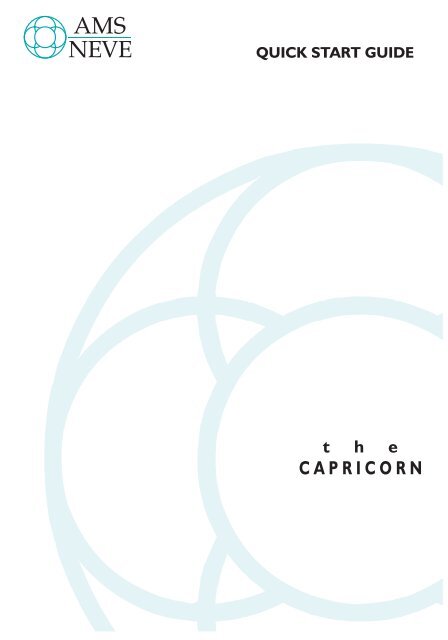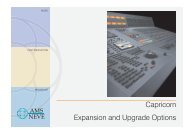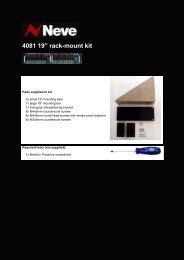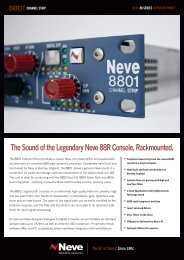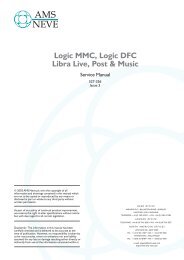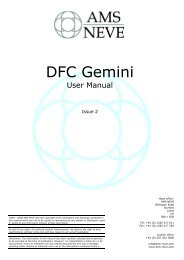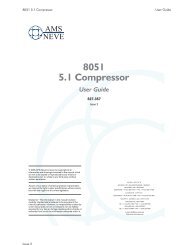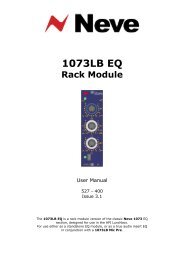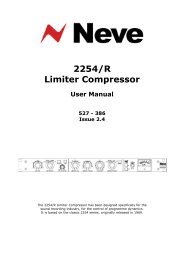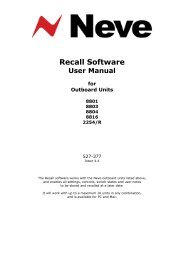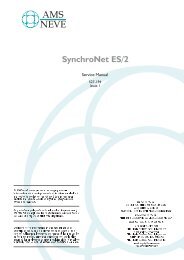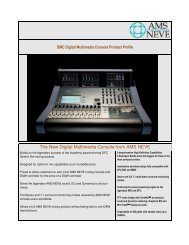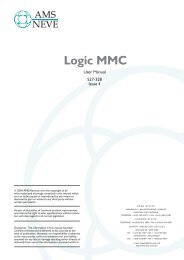Quick Start Manual - AMS Neve
Quick Start Manual - AMS Neve
Quick Start Manual - AMS Neve
You also want an ePaper? Increase the reach of your titles
YUMPU automatically turns print PDFs into web optimized ePapers that Google loves.
QUICK START GUIDE<br />
t h e<br />
CAPRICORN
Capricorn<br />
<strong>Quick</strong> <strong>Start</strong> Guide<br />
Contents<br />
1 Introduction<br />
2 Capricorn Description<br />
3 Three Sections<br />
3 The Graphic Display System<br />
4 System Screen<br />
5 System Connections<br />
6 Locating Controls<br />
7 Console Setup/Recording<br />
7 System Configuration<br />
7 Strip Assignment<br />
8 To place Tape Return Monitors on Bank 1<br />
8 To place Inputs on Bank 2<br />
9 To place Aux Masters on Bank 1<br />
9 To place Main Outputs on Bank 1<br />
10 Tape Machine Set-up<br />
10 Timecode<br />
10 Tape Machine Monitor<br />
11 Configure Input and Output Ports<br />
12 Making Paths Stereo<br />
13 Routing<br />
13 To route tape returns to main output bus<br />
13 Routing Inputs to Tracks<br />
13 Routing Inputs to Groups<br />
13 Routing Inputs to the Mix (FX returns etc)<br />
14 Reverse Routing<br />
14 Selecting Mic or Line Input<br />
14 Changing an Inputs Phase<br />
14 Phantom Power<br />
14 Monitoring the desk outputs<br />
15 Configuring Processing<br />
15 Modify<br />
16 Auxiliaries and Cues<br />
16 AUX Sends<br />
17 AUX Masters<br />
17 HEADPHONES / CUE SEND control.<br />
18 Using Capricorn like an in-line console<br />
20 Machine Control<br />
20 Track Arming (Record Ready)<br />
20 Cycle and Locate<br />
20 Locating<br />
21 Cycle<br />
22 Configuration<br />
22 Naming paths & banks<br />
22 To store a configuration<br />
22 To recall a configuration<br />
Issue 2.0
<strong>Quick</strong> <strong>Start</strong> Guide<br />
Capricorn<br />
23 Automation<br />
23 Automation session flowchart<br />
24 <strong>Quick</strong> <strong>Start</strong><br />
25 Automation Controls<br />
25 Scope<br />
26 Mix Basics<br />
26 Mix Passes<br />
26 Going Back To Earlier Mix Passes<br />
26 Mix Pass Numbers<br />
27 Instant Undo<br />
27 Mix Tree<br />
27 Exiting Automation<br />
28 Automation Modes<br />
28 Touch Record<br />
29 Record<br />
30 Auto Glide<br />
31 <strong>Manual</strong> Glide<br />
32 Auto Takeover<br />
33 Trim<br />
35 Play<br />
36 Isolate<br />
37 Mute/Switch Automation<br />
37 Add Mode<br />
38 Write Mode<br />
39 Double Press Operation Of Mutes And Other Switches<br />
40 Collect Touch<br />
41 Other Useful Functions<br />
41 Copying Control Parameters<br />
41 Linking Controls<br />
41 To make a Link<br />
42 Fader To AUX Copy<br />
43 Other Advanced Features<br />
43 Off Line Edits<br />
43 Mix Compare/Merge<br />
43 Record to End<br />
43 Stores<br />
44 Surround Sound<br />
45 Index<br />
Issue 2.0
Capricorn<br />
<strong>Quick</strong> <strong>Start</strong> Guide<br />
Introduction<br />
This Guide has been specifically created to provide users of traditional<br />
analogue desks (and occasional or inexperienced Capricorn users) with a<br />
basic ‘quick start’ operational guide to the ‘all digital’ Capricorn desk.<br />
To achieve this it uses straightforward everyday descriptions supported<br />
by actual examples (icons) from the system’s package and a range of<br />
schematics and graphic representations of relevant features and their<br />
location relative to the system’s work surface.<br />
The <strong>Quick</strong> <strong>Start</strong>e Guide will provide operators with everything they need<br />
to quickly and easily gain practical mixing skills with one of the world’s<br />
most powerful desks.<br />
Issue 2.0 1
<strong>Quick</strong> <strong>Start</strong> Guide<br />
Capricorn<br />
Capricorn Description<br />
Capricorn is a multitrack mixing console - specifically designed for the<br />
recording, broadcast and post-production industries - to be used in large<br />
scale multitrack recording, mixing and overdubbing applications.<br />
Its principle features include the following:<br />
<br />
<br />
<br />
<br />
<br />
<br />
<br />
Total Digital Signal Path - using Applications Specific<br />
Circuits which offer more than just the advantages of<br />
digital sound but also the blend, warmth and<br />
musicality you would normally associate with the<br />
`<strong>Neve</strong> sound’.<br />
Total Reset - all of Capricorn’s processing<br />
parameters can be recalled and reset with absolute<br />
accuracy.<br />
Total Dynamic Automation - of all the consoles<br />
principle mixing functions.<br />
Personalised Configuration - for each project and or<br />
operator.<br />
Assignability - means that there is no need for a<br />
dedicated strip of controls for each input and output,<br />
every size of control surface is capable of operating<br />
the largest system size.<br />
Instinctive Updating - allows operators wanting to<br />
update a control position to simply touch the control<br />
before making the adjustment.<br />
Touch Sensitivity - all rotary and linear controls are<br />
touch sensitive allowing instant control of recording<br />
and enabling displays to indicate absolute values for<br />
controls in touch.<br />
2 Issue 2.0
Capricorn<br />
<strong>Quick</strong> <strong>Start</strong> Guide<br />
Three Sections<br />
The desk is divided into three sections with each section completely<br />
self-contained - including their own power supplies.<br />
They are as follows:<br />
<br />
<br />
<br />
The Channel Section<br />
The AFU or Assignable Facilities Unit<br />
The Monitor Section<br />
A high resolution colour monitor provides control of the consoles<br />
interactive graphic user interface along with a QWERTY keyboard and<br />
trackball.<br />
The Graphic Display System<br />
The system is used for off-line functions such as:<br />
<br />
<br />
<br />
<br />
<br />
<br />
<br />
<br />
Setting/displaying signal path information<br />
Naming paths and banks for console display<br />
Strip assignment<br />
Port routing<br />
Disk and memory management<br />
System configuration<br />
Setting options<br />
Tape machine configuration<br />
(All signal and processing elements are housed in a separate 42U high<br />
processing rack. This rack also contains the hard disk, a 3.5 Floppy disk<br />
drive and a 3.5 Magneto Optical disc drive - used for configuration and<br />
automation data storage).<br />
Issue 2.0 3
<strong>Quick</strong> <strong>Start</strong> Guide<br />
Capricorn<br />
System Screen<br />
The system screen is divided into three separate areas.<br />
48 00:00:00:00.0<br />
I12<br />
HOLD<br />
99%<br />
00:24:30:12.0<br />
1 The Application Window<br />
Used for creating, editing and displaying information<br />
A pop-up dialogue box will overlay the application window with prompts,<br />
error messages, selection lists and option switches when the application<br />
needs to talk to the operator.<br />
2 The Icon Menu<br />
System icons are displayed in this area in boxes which are highlighted<br />
when the cursor is moved onto them.<br />
3 The System Status Area<br />
Gives a permanent display of system level data such as timecode and<br />
automation status.<br />
Trackball<br />
The trackball provides control of a cursor for both pointing and selection.<br />
It can also be used to modify data values on screen during editing and for<br />
configuring or moving audio processing components in the signal path.<br />
4 Issue 2.0
Capricorn<br />
<strong>Quick</strong> <strong>Start</strong> Guide<br />
System Connections<br />
Capricorn 48 Console<br />
VDU<br />
Mic/Line Rack<br />
Mic/Line Rack<br />
Mic/Line Rack<br />
Analogue I/O Rack<br />
DSP Rack<br />
Digital I/O Rack<br />
Machine Control<br />
Rack<br />
DAT<br />
TB<br />
Monitor Facilities<br />
Rack<br />
Auto<br />
Locator<br />
Spare MADI Port<br />
8MADIPorts<br />
Issue 2.0 5
<strong>Quick</strong> <strong>Start</strong> Guide<br />
Capricorn<br />
Locating Controls<br />
Throughout the manual are graphic representations of specific sections of<br />
the console indicating the position of controls within those sections.<br />
CHAN<br />
CHAN<br />
CHAN<br />
AFU<br />
MON<br />
CHAN<br />
CHAN<br />
CHAN<br />
Typical 48 fader control surface<br />
These have been included to facilitate ease of location when for example<br />
a specific key is named as part of an operational sequence.<br />
EXAMPLE:<br />
To find the `PLAY KEY’ within the tape transport<br />
section see the diagram adjacent.<br />
MON<br />
6 Issue 2.0
Capricorn<br />
<strong>Quick</strong> <strong>Start</strong> Guide<br />
Console Setup/Recording<br />
This first section allows the operator to create a custom mix set-up from<br />
scratch, from power-up to a state where a session can take place.<br />
System Configuration<br />
Click on the PATH NUMBERS icon to select<br />
system size (number of auxes, outputs etc)<br />
For our trial-run session we will use the following basic set up:<br />
Inputs 22<br />
Monitors 24<br />
Groups 8<br />
Main Outputs 2<br />
Aux Masters 4<br />
Cue Sends 2<br />
Click on EXECUTE.<br />
Strip Assignment<br />
Click on the BANK ASSIGN icon to “assign<br />
strips”.<br />
Choose a bank by clicking on the blue numbered<br />
boxes then click on ASSIGN STRIPS. (If any are<br />
already assigned, click on DE-ASSIGN ALL).<br />
Click on the STRIP NUMBER dialogue box.<br />
Select the strip you wish the assignment to start<br />
from, either by using the trackball or cursor keys.<br />
Alternatively press the ACCESS key on the strip<br />
you wish the assignment to start from.<br />
Click again to EXECUTE.<br />
Select paths to be assigned on to the strips by<br />
clicking on the list of available paths.<br />
HINT: Use the scroll key and trackball to choose from paths out of view.<br />
Issue 2.0 7
<strong>Quick</strong> <strong>Start</strong> Guide<br />
Capricorn<br />
To place Tape Return Monitors on Bank 1<br />
Click on blue box for Bank 1.<br />
Click on ASSIGN STRIPS.<br />
Click on STRIP dialogue box.<br />
Select the cursor to SCROLL.<br />
Scroll down the list to MONITORS.<br />
Click on (turns yellow) Monitors 1 through 24.<br />
EXECUTE.<br />
To place Inputs on Bank 2<br />
Click on blue box for Bank 2.<br />
Click on ASSIGN STRIPS.<br />
Click on STRIP dialogue box.<br />
Select the cursor to SCROLL.<br />
Scroll down the list to INPUTS.<br />
Click on (turns yellow) Inputs 1 through 22.<br />
EXECUTE.<br />
8 Issue 2.0
Capricorn<br />
<strong>Quick</strong> <strong>Start</strong> Guide<br />
To place Aux Masters on Bank 1<br />
Click on blue box for Bank 1.<br />
Click on ASSIGN STRIPS.<br />
Click on STRIP dialogue box.<br />
Select the cursor to SCROLL.<br />
Scroll down the list to AUXS.<br />
Click on (turns yellow) Auxes 1 through 4.<br />
EXECUTE.<br />
To place Main Outputs on Bank 1<br />
Click on blue box for Bank 1.<br />
Click on ASSIGN STRIPS.<br />
Click on STRIP dialogue box.<br />
Select the cursor to SCROLL.<br />
Scroll down the list to OUTPUTS.<br />
Click on (turns yellow) Outputs 1&2.<br />
EXECUTE.<br />
Issue 2.0 9
<strong>Quick</strong> <strong>Start</strong> Guide<br />
Capricorn<br />
Tape Machine Set-up<br />
Click on the TAPE MACHINE icon to assign the<br />
tape machine.<br />
Click on the top box and choose a tape machine<br />
from the right hand list.<br />
Click on MADI LINKS. This opens the MADI link<br />
assignment sub-menu.<br />
Click on MULTITRACK and then on the I/O TAPE<br />
MACHINE icon to connect the MADI link to the<br />
tape machine.<br />
Is the clock rate OK? (either 44.1kHz or 48kHz sampling frequency).<br />
To change the sample rate click in the sample<br />
rate box (above left of the timecode display).<br />
Click on the SAMPLE FREQUENCY icon to adjust<br />
the sample rate.<br />
Timecode<br />
If a new rate needs selecting, click on the<br />
TIMECODE icon to change.<br />
Tape Machine Monitor<br />
Select the desk monitoring to RET on the monitor<br />
section of the console.<br />
MON<br />
<strong>Start</strong> the tape machine by pressing the PLAY<br />
transport key, and the input meters should<br />
indicate that a signal is present.<br />
10 Issue 2.0
Capricorn<br />
<strong>Quick</strong> <strong>Start</strong> Guide<br />
Configure Input and Output Ports<br />
Click on the PATH CONFIG icon to “port route”<br />
main outputs, aux/cue outputs etc to analogue or<br />
digital destinations. The main output, aux or cue<br />
meters will not indicate until this is done.<br />
Press the ACCESS key on the output strip<br />
required.<br />
Click on PATH CONFIG icon<br />
Click on the output port to assign an output port.<br />
This brings up the output port sub-menu.<br />
Click on analogue or digital.<br />
Click on the port output required.<br />
Click on the PATH CONFIG icon again to check<br />
that inputs are port routed (mic/line signal is<br />
getting to the channel path).<br />
Click on source port to assign a port. This brings<br />
up the input port sub-menu.<br />
Click on analogue or digital.<br />
Click on the port input required.<br />
Issue 2.0 11
<strong>Quick</strong> <strong>Start</strong> Guide<br />
Capricorn<br />
Making Paths Stereo<br />
To make a path within Capricorn stereo (eg. main<br />
output, input, aux, cue etc), ACCESS the path<br />
you wish to be the left leg of a stereo pair.<br />
Click on the PATH CONFIG icon.<br />
Click on the STEREO dialogue box.<br />
Select which path you wish to be the right leg of<br />
the stereo pair if appropriate.<br />
EXECUTE.<br />
12 Issue 2.0
Capricorn<br />
<strong>Quick</strong> <strong>Start</strong> Guide<br />
Routing<br />
To route tape returns to main output bus<br />
Press the ACCESS key on the required channel<br />
and select the output on the routing matrix on the<br />
meter bridge above the AFU.<br />
Routing Inputs to Tracks<br />
Press ACCESS on Input 1 (for example).<br />
Select track(s) required on routing matrix above<br />
the AFU.<br />
Continue routing as per the above steps.<br />
Routing Inputs to Groups<br />
Press ACCESS on Input 1 (for example).<br />
Select group(s) required on Group Routing Panel<br />
above AFU.<br />
Continue routing as per the above steps.<br />
Routing Inputs to the Mix (FX returns etc)<br />
Press ACCESS on Input 1 (for example).<br />
Select output(s) required on Output Routing<br />
Panel above AFU.<br />
Continue routing as per the above steps.<br />
Issue 2.0 13
<strong>Quick</strong> <strong>Start</strong> Guide<br />
Capricorn<br />
Reverse Routing<br />
Press ROUTE on the main routing panel.<br />
Select the destination on the main routing panel,<br />
eg. main output, group etc.<br />
Press the ACCESS keys on the sources you wish<br />
to route to the selected output.<br />
Press ROUTE again to execute.<br />
Selecting Mic or Line Input<br />
Press ACCESS on Input 1 (for example).<br />
Select either Mic A or B or Line A or B on AFU.<br />
Changing an Inputs Phase<br />
Press ACCESS on Input 1 (for example).<br />
Press Phase key on the AFU to Invert channels<br />
Phase.<br />
Phantom Power<br />
Press ACCESS on Input 1 (for example).<br />
Press the +48 key on the AFU to activate<br />
channels Phantom Power.<br />
Monitoring the desk outputs<br />
Press the console’s O/P key (next to the control<br />
room pot).<br />
MON<br />
Press the number of the output port (usually 1 &<br />
2) that you wish to monitor on the 16-way<br />
selector (between the control room pot and the<br />
tape transport keys).<br />
Adjust the volume with the control room pot.<br />
14 Issue 2.0
Capricorn<br />
<strong>Quick</strong> <strong>Start</strong> Guide<br />
Configuring Processing<br />
This is for configuring EQs, gates, etc.<br />
Click on the PATH CONFIG icon to assign<br />
processing to whatever channel is currently<br />
accessed.<br />
Select processing, gates, EQs etc by clicking on<br />
the processing element required and then<br />
moving the jack plug to the desired position.<br />
Click again to place it.<br />
Modify<br />
To KEY or INVERT a channel's GATEs or LINK Control Voltages of<br />
COMPRESSORS and LIMITERS:<br />
ACCESS the desired channel.<br />
Assign processing as required.<br />
Click on MODIFY (to change processors<br />
characteristics or keying).<br />
Click on desired processor, Gate, Compressor<br />
etc.<br />
Issue 2.0 15
<strong>Quick</strong> <strong>Start</strong> Guide<br />
Capricorn<br />
Auxiliaries and Cues<br />
AUX Sends<br />
There are several ways in which the engineer can set up AUX sends.<br />
Here are two very simple ways:<br />
Press the ACCESS key on a channel strip.<br />
Turn the AUX contribution control for the<br />
respective AUX bus on the AFU.<br />
To select an AUX bus to the channel strip FACs<br />
press the AUX select key at the end of the 2nd or<br />
3rd row of FACs on the AFU.<br />
Press the number key on the required AUX bus.<br />
The respective bus will now be available<br />
desk-wide.<br />
If the Aux is STEREO, the third FAC acts as a<br />
PAN.<br />
HINT: For setting up headphone mixes on an Aux, try setting all<br />
channels to the same desired Aux then press the AUX on the AFU to<br />
use the FADERS to MIX the AUX’s. When you have finished, end this<br />
mode by again pressing AUX on the AFU.<br />
16 Issue 2.0
Capricorn<br />
<strong>Quick</strong> <strong>Start</strong> Guide<br />
AUX Masters<br />
Assign AUX paths to a Bank in the same way as<br />
Channels, Monitors, etc.<br />
The AUX Master level can then be adjusted using<br />
the fader.<br />
Press the appropriate ACCESS key to use the<br />
processing and porting functions from the AFU<br />
and PATH CONFIGURATION, as for other paths.<br />
HEADPHONES / CUE SEND control.<br />
Headphones can be fed from several sources including the consoles mix<br />
output, the Aux sends etc. Headphone sends are called CUE’s.<br />
Assign CUE paths to a Bank in the same way as<br />
Channels, Monitors, etc.<br />
The CUE Master level can then be adjusted using<br />
the fader.<br />
Press the appropriate ACCESS key to use the<br />
processing and porting functions from the AFU<br />
and PATH CONFIGURATION, as for other paths.<br />
Use the CUE CONTROL panel to select type of<br />
source to feed to cues (eg Aux or Ext etc)<br />
followed by the number of the source on the 16<br />
way matrix (eg. choose 12 for Aux 12 etc).<br />
Issue 2.0 17
<strong>Quick</strong> <strong>Start</strong> Guide<br />
Capricorn<br />
Using Capricorn like an in-line console<br />
NOTE: An In-Line console's channel contains two signal paths, Tape<br />
Return and Channel Input. Capricorn can be used to emulate this way of<br />
working by using two Banks out of the 12 available.<br />
As Capricorn has two rows of ACCESS keys but one row of faders the<br />
engineer can switch between the Tape Returns (on BANK 1) and<br />
Channel Inputs (on BANK 2) rather like “Fader Flipping” on an In-Line<br />
console.<br />
Switching between BANKS.<br />
To ACCESS the desired channel (which gives<br />
fuller control on the AFU) press its ACCESS key.<br />
This channel is now currently on the surface.<br />
NOTE: The top row of ACCESS keys for BANK 1 are known as the<br />
PRIMARY BANK, the lower row of ACCESS keys for BANK 2 are known<br />
as the SECONDARY BANK.<br />
To select which Banks are available on the surface:<br />
Both the Primary and Secondary Banks can be<br />
available at any one time on the surface.<br />
To select Bank 1 on to the top row, press BANK 1<br />
on the small LED screen on the AFU.<br />
To select Bank 2 on to the lower row press “SEC<br />
BANK” then press BANK 2.<br />
Any processing, signals etc that are out of sight on Banks that are not<br />
shown continue to function, they are just hidden.<br />
18 Issue 2.0
Capricorn<br />
<strong>Quick</strong> <strong>Start</strong> Guide<br />
To select the function for the top row of FACs (eg. I/P SEL, GAIN<br />
etc):<br />
Press the respective function select key on the<br />
adjacent FAC SELECTION panel on the AFU.<br />
The second and third row of FAC controls are<br />
usually used for AUX contribution - see page 16.<br />
The fourth row of FACs usually control PAN,<br />
WIDTH or BALANCE.<br />
To select EQ across all channel strip FACs:<br />
Press EQ in the FAC SELECTION panel. The top<br />
FAC now selects the EQ band, the second<br />
controls FREQUENCY, the third controls GAIN<br />
and the fourth controls Q.<br />
Issue 2.0 19
<strong>Quick</strong> <strong>Start</strong> Guide<br />
Capricorn<br />
Machine Control<br />
Track Arming (Record Ready)<br />
On MACHINE TRACK CONTROL panel select<br />
desired machine, A, B or C.<br />
On the 48 way track matrix select tracks that you<br />
wish to arm.<br />
MON<br />
Cycle and Locate<br />
Press NEW LABEL.<br />
Type in the name of the label point if desired.<br />
EXECUTE<br />
MON<br />
At end of the section press NEW LABEL.<br />
Type in the name of the label point if desired.<br />
EXECUTE<br />
NOTE: Whenever NEW LABEL is pressed the engineer is prompted for a<br />
name (which is optional) and that label is added to the LABEL LIST.<br />
Locating<br />
There are several ways to use Locate with Capricorn. Here is just one<br />
example:<br />
Press the LOCATE key on tape transport.<br />
Select desired label number from the numeric<br />
keypad, followed by STOP or PLAY on the tape<br />
transport keys.<br />
MON<br />
20 Issue 2.0
Capricorn<br />
<strong>Quick</strong> <strong>Start</strong> Guide<br />
Cycle<br />
To cycle between two points:<br />
Click on LABEL LIST icon.<br />
Cursor to the first (FROM) label and click.<br />
Click on dots after Timecode numbers.<br />
Click on FROM marker.<br />
EXECUTE.<br />
Cursor to the end (TO) label and click.<br />
Click on dots after Time code numbers.<br />
Click on TO marker.<br />
EXECUTE<br />
On tape transport, press CYCLE, then LOCATE<br />
then PLAY to begin the cycle.<br />
STOP on transport controls halts the cycle.<br />
MON<br />
Issue 2.0 21
<strong>Quick</strong> <strong>Start</strong> Guide<br />
Capricorn<br />
Configuration<br />
Naming paths & banks<br />
Click on the PATH NAMES icon to name channel<br />
paths:<br />
Click on the list of channels and type in the new<br />
name followed by RETURN.<br />
Click on the BANK ASSIGN icon to name banks.<br />
Click on the required bank name and type in the<br />
new name followed by RETURN.<br />
To store a configuration<br />
Click on the USER SELECT icon.<br />
Click on SYSTEM MANAGER then ADD to enable<br />
you to add your name as a new user.<br />
Click on your user name to select yourself as the<br />
new user.<br />
Click on the STORAGE icon to add the name of<br />
the new configuration (this can now be your<br />
default configuration).<br />
To recall a configuration<br />
At a later stage, to recall your configuration, first<br />
click the USER SELECT icon to select your name.<br />
Click on the STORAGE icon then select the<br />
configuration required.<br />
22 Issue 2.0
Capricorn<br />
<strong>Quick</strong> <strong>Start</strong> Guide<br />
Automation<br />
Automation session flowchart<br />
This section allows operators to take maximum advantage of Capricorn’s<br />
powerful automation features.<br />
CONTINUE WITH<br />
AN OLD MIX<br />
LOG ON<br />
BRAND NEW<br />
MIX<br />
SCOPE<br />
(decide what<br />
to automate)<br />
START<br />
MIXING<br />
LOG OUT<br />
NOTE: If someone has been using the console before you, log them out<br />
of automation first by selecting CLIENTS icon and clicking on LOG OUT<br />
box.<br />
AUTOMATION<br />
ON<br />
PLAY SAFE<br />
Global Mode selection for all controls<br />
except Mute keys and Faders<br />
PLAY<br />
COL<br />
TOUCH<br />
REC<br />
GLIDE<br />
SW<br />
MATCH<br />
RECORD<br />
TO END<br />
AUTOMATION<br />
SCOPE<br />
Global Mode selection for Mute keys<br />
MUTE<br />
PLAY<br />
MUTE<br />
REC<br />
MUTE<br />
MATCH<br />
FDR<br />
PLAY<br />
FDR<br />
REC<br />
Global Mode selection for Faders<br />
TRIM<br />
GLIDE<br />
MASTER<br />
RECORD<br />
ALL MATCH<br />
REHEARSE<br />
MIX<br />
-<br />
MIX<br />
+<br />
PASS<br />
-<br />
PASS<br />
+<br />
Before the mix automation system can be initiated, the system needs to<br />
be informed where to store and retrieve data for the session.<br />
Issue 2.0 23
<strong>Quick</strong> <strong>Start</strong> Guide<br />
Capricorn<br />
User Log-On<br />
• Current User •<br />
Default<br />
• Known Users •<br />
Default<br />
System Manager<br />
Dudley Saville<br />
Peter East<br />
Sheila Rexell<br />
Close<br />
PASSWORD<br />
23 Oct 95 11:24:50<br />
17 Dec 95 15:45:44<br />
19 Sep 95 09:21:21<br />
27 Nov 95 13:03:31<br />
9Jan96 19:37:54<br />
Select Add Rename Delete<br />
Select a CLIENT from the list by clicking on the<br />
appropriate client. eg. YOUR CLIENT.<br />
Select a PROJECT from the list by clicking on it<br />
or ADD a new project by clicking on the ADD box<br />
and entering a project name. eg. YOUR<br />
PROJECT.<br />
Select a TITLE or create a new TITLE by clicking<br />
in ADD box and typing the new titles name. eg.<br />
YOUR TITLE.<br />
<strong>Quick</strong> <strong>Start</strong><br />
Capricorn has been designed to enable automation to be used without<br />
going through the preceding operation. Using this method the previous<br />
mix tree will be deleted automatically each time QUICK START is used.<br />
Press the AUTOMATION ON key on the AFU’s<br />
GLOBAL AUTOMATION CONTROLS panel. This<br />
will bring up the client menu.<br />
Click on all default cursor positions until a mix<br />
tree has been created. The AUTOMATION ON led<br />
will go on solid.<br />
24 Issue 2.0
Capricorn<br />
<strong>Quick</strong> <strong>Start</strong> Guide<br />
Automation Controls<br />
Separate automation control keys are provided on a strip basis for faders<br />
and mutes. The remainder of rotary controls and switches that may be<br />
dynamically automated are controlled by a separate set of mode control<br />
keys situated at the top of each channel strip.<br />
For the accessed path these controls are mirrored by the automation<br />
keys on the AFU.<br />
Global mode control keys are provided in the monitor section for faders<br />
and mutes. A separate set of global mode keys are provided to control all<br />
other rotary and switch controls that may be dynamically automated<br />
except faders and mutes.<br />
Scope<br />
Scope provides the facility to select or reduce the number of controls that<br />
are recognised by automation.<br />
The engineer may only want to have say faders and mutes automated at<br />
the beginning of the mix session because if everything was automated (or<br />
in automation SCOPE) he would be recording experimental tweaks with<br />
the EQ etc. Once that the engineer decides to automate Aux’s for<br />
example he can just call up the SCOPE PAGE.<br />
Click the SCOPE icon.<br />
Click the AUTOMATION button in SCOPE MENU<br />
page.<br />
Click on “ALL PATHS”.<br />
Click on the facilities that you want to be<br />
automated (turns yellow) or<br />
On AFU, touch the controls that are required, red<br />
LEDs indicate that they are in.<br />
EXECUTE and then confirm scope settings.<br />
Issue 2.0 25
<strong>Quick</strong> <strong>Start</strong> Guide<br />
Capricorn<br />
Mix Basics<br />
Every mix pass is kept on the hard disk.<br />
Every mix pass is kept on your removable media which means that you<br />
can play any pass at a later date in a different location.<br />
Mix Passes<br />
Going Back To Earlier Mix Passes<br />
Press MIX - to go back a mix.<br />
Press MIX + to go forward a mix.<br />
Press PASS - to go back a pass.<br />
Press PASS + to go forward a pass.<br />
EXECUTE.<br />
Mix Pass Numbers<br />
Every time that you run the tape and make an adjustment, that pass is<br />
kept and given a number which increments up a number as you make<br />
adjustments with each pass. The first Mix Pass number would be Mix 1,<br />
Pass 1. The sixth pass will be called Mix 1, Pass 6 etc.<br />
At any time you can step back through each mix pass.<br />
If you step back from the current pass, say Mix 1, Pass 6 to any previous<br />
pass, the next Mix Pass number will be Mix 2, Pass 1. The next pass<br />
would be Mix 2, Pass 2 and so on.<br />
26 Issue 2.0
Capricorn<br />
<strong>Quick</strong> <strong>Start</strong> Guide<br />
Instant Undo<br />
The PASS- key can be used to abort the current record pass before the<br />
transport is stopped. If an incorrect move is made:<br />
Press the PASS- key while the transport is still<br />
running.<br />
Stop the transport.<br />
The Pass will be discarded so that you can rewind and make the correct<br />
move without having to go back to the Mix Tree.<br />
Mix Tree<br />
Mix Tree<br />
Close<br />
0.0<br />
1.1 1.2 1.3 1.4 1.5 1.6<br />
2.1 2.2 2.3<br />
Home<br />
Delete<br />
Display<br />
Milestone<br />
Compress<br />
Text<br />
Cancel<br />
Execute<br />
Click on MIX TREE icon to view all of the MIX<br />
PASSES.<br />
Exiting Automation<br />
Click on “CLIENTS” icon.<br />
Click on “LOG OUT” box.<br />
Issue 2.0 27
<strong>Quick</strong> <strong>Start</strong> Guide<br />
Capricorn<br />
Automation Modes<br />
These modes apply to all controls wherever appropriate. Mutes for<br />
example do not need or have glide or VCA style Trim. FAC’s do not need<br />
VCA style Trim either.<br />
Touch Record<br />
Faders<br />
FAC<br />
PURPOSE<br />
Allows the operator to add an offset to an existing move.<br />
OPERATION<br />
Press the respective RECORD and PLAY keys<br />
simultaneously on the fader, strip, AFU, or<br />
globally on the monitor section.<br />
When you touch the control it goes into record<br />
and all moves that you make are recorded.<br />
On release of the control it drops out of record<br />
and the control resumes replay of the play pass.<br />
28 Issue 2.0
Capricorn<br />
<strong>Quick</strong> <strong>Start</strong> Guide<br />
Record<br />
Faders<br />
FAC<br />
PURPOSE<br />
To record new absolute positions<br />
OPERATION<br />
Press the respective RECORD key on the fader,<br />
strip, AFU, or globally on the monitor section.<br />
When you touch the control, it goes into record,<br />
the led starts to flash and all moves that you<br />
make are recorded.<br />
On release of the control the control will continue<br />
in record as if being touched staying at the<br />
position where you released it.<br />
Issue 2.0 29
<strong>Quick</strong> <strong>Start</strong> Guide<br />
Capricorn<br />
Auto Glide<br />
Faders<br />
FAC<br />
PURPOSE<br />
Allows the operator to automatically remove offsets.<br />
OPERATION<br />
Press the respective RECORD and GLIDE keys<br />
simultaneously on the fader, strip, AFU, or<br />
globally on the monitor section.<br />
When you touch and move the control from the<br />
play pass position the moves you make will be<br />
recorded.<br />
On release of the control, the control will glide<br />
back to the play pass position at the glide rate<br />
set for “auto glide time”.<br />
30 Issue 2.0
Capricorn<br />
<strong>Quick</strong> <strong>Start</strong> Guide<br />
<strong>Manual</strong> Glide<br />
Faders<br />
FAC<br />
PURPOSE<br />
This mode allows the operator to null out an offset at any time at the<br />
press of a key.<br />
OPERATION<br />
When you touch and move the control from the<br />
play pass position the moves you make will be<br />
recorded.<br />
At the time that you wish to match the controls<br />
either locally or globally, press the respective<br />
GLIDE key, and the controls will glide back to the<br />
play pass position at the glide rate set for manual<br />
glide.<br />
Issue 2.0 31
<strong>Quick</strong> <strong>Start</strong> Guide<br />
Capricorn<br />
Auto Takeover<br />
PURPOSE<br />
Allows the operator to manually null a fader or rotary control back to the<br />
play pass position without using the nulling LEDs.<br />
OPERATION<br />
Faders and rotary controls may be in either Record or Touch Record<br />
modes.<br />
When you touch and move the control from the<br />
play pass position the moves that you make will<br />
be recorded.<br />
At the time you wish to match the control<br />
manually to the play pass position, press the<br />
GLIDE key associated with the respective control<br />
WHILST YOU ARE STILL TOUCHING THE<br />
CONTROL.<br />
As you move the control past the play pass<br />
position, the control will automatically match and<br />
drop out of record at the play pass position.<br />
32 Issue 2.0
Capricorn<br />
<strong>Quick</strong> <strong>Start</strong> Guide<br />
Trim<br />
Faders<br />
Trim is only available for faders.<br />
PURPOSE<br />
Used to add an offset to a previously recorded mix in a similar way to<br />
VCA type automation systems.<br />
OPERATION<br />
Press the TRIM key either locally on the channel<br />
strip, or globally on the monitor section.<br />
The faders selected will jump to the zero position as indicated by the left<br />
hand fader scale.<br />
Pressing TRIM and GLIDE together will select the<br />
AUTO TRIM mode.<br />
The faders show two scales. The right hand scale reads from infinity to<br />
+10 and is relevant to normal fader operations. The left hand scale<br />
indicates 0 in the middle of the scale and shows +20dB and –20dB.<br />
The left hand scale is used exclusively in TRIM mode.<br />
When TRIM mode is selected the fader jumps to<br />
the centre of the fader scale. When tape is started<br />
the fader will remain stationary at the zero<br />
position irrespective of the original position of<br />
the play pass or any dynamic moves that may<br />
have been written.<br />
Issue 2.0 33
<strong>Quick</strong> <strong>Start</strong> Guide<br />
Capricorn<br />
By moving the fader +/– you can increase the<br />
dynamic or static gain structure of previously<br />
written fader movements by +/–20dB without<br />
overwriting the dynamic moves during the period<br />
you are touching the fader.<br />
34 Issue 2.0
Capricorn<br />
<strong>Quick</strong> <strong>Start</strong> Guide<br />
Play<br />
PURPOSE<br />
Faders FAC Mutes<br />
Used to monitor a mix pass.<br />
OPERATION<br />
Press the PLAY key either locally on the fader,<br />
strip, or AFU for the accessed path or globally on<br />
the monitor section.<br />
When you touch and move the control from the<br />
play pass position, the moves that you make will<br />
be heard but automation will not be updated and<br />
you will not create a new record pass.<br />
Issue 2.0 35
<strong>Quick</strong> <strong>Start</strong> Guide<br />
Capricorn<br />
Isolate<br />
PURPOSE<br />
Faders FAC Mutes<br />
Controls are isolated from the automation system and will not playback<br />
the automation data or record new data.<br />
Isolate is available to faders, rotary controls, mutes and switches.<br />
OPERATION<br />
Press PLAY twice for the respective function,<br />
either locally or globally.<br />
Moves may now be made without effecting automation and previous mix<br />
positions will not be replayed.<br />
36 Issue 2.0
Capricorn<br />
<strong>Quick</strong> <strong>Start</strong> Guide<br />
Mute/Switch Automation<br />
All mute/switch functions in Capricorn that may be dynamically automated<br />
operate in the same way.<br />
Add Mode<br />
This is analogous to the fader TOUCH RECORD mode and is the default<br />
mode.<br />
FAC<br />
Mutes<br />
Press the MUTE RECORD and MUTE PLAY keys<br />
associated with the mute key.<br />
Pressing RECORD and PLAY keys at the top of<br />
the channel strip sets all the switches associated<br />
with the strip (except the mute key) to the ADD<br />
mode.<br />
Pressing RECORD and PLAY on the AFU sets all<br />
the switches for the accessed path to the ADD<br />
mode and mirrors the automation keys on top of<br />
the channel strip.<br />
Issue 2.0 37
<strong>Quick</strong> <strong>Start</strong> Guide<br />
Capricorn<br />
Write Mode<br />
This is analogous to the fader RECORD mode.<br />
FAC<br />
Mutes<br />
Press the MUTE RECORD key associated with<br />
the mute key.<br />
Pressing the RECORD key at the top of the<br />
channel strip sets all the switches associated<br />
with the strip (except the mute key) to the WRITE<br />
mode.<br />
Pressing RECORD on the AFU sets all the<br />
switches for the accessed path to the WRITE<br />
mode, and mirrors the automation keys on top of<br />
the channel strip.<br />
38 Issue 2.0
Capricorn<br />
<strong>Quick</strong> <strong>Start</strong> Guide<br />
Double Press Operation Of Mutes And Other<br />
Switches<br />
The Mutes and other switches have a special “double press” feature<br />
allowing the engineer to quickly edit mutes or other automated switches<br />
without having to use the computer screen. As the name suggests, the<br />
switches have a double press feel. The first press is the same as say<br />
holding a finger on a fader, the current position is maintained. The second<br />
press is to INVERT the switches state, say turning a Mute to an<br />
UN-MUTE.<br />
When the key is pressed lightly the RED LED above lights up. You are<br />
now maintaining the state that the switch or mute is in. So if it is un-muted<br />
you will keep it un muted while holding it in this position over writing<br />
upcoming mutes.<br />
If in UPDATE mode, once you let go of the switch<br />
it will wait until the next change and then<br />
continue as before.<br />
If in RECORD (or WRITE) once you let go of the<br />
switch it will continue with the current state.<br />
Issue 2.0 39
<strong>Quick</strong> <strong>Start</strong> Guide<br />
Capricorn<br />
Collect Touch<br />
Collect Touch provides the operator with the facility to put any group of<br />
controls that may be automated into a state of RECORD either prior to<br />
the start of a new pass, or drop the controls into RECORD at a specific<br />
point in a pass.<br />
GLOBAL OPERATION<br />
Press the master COL TOUCH key.<br />
Touch the required controls on the strips or the<br />
AFU and set the new control positions as<br />
desired.<br />
MON<br />
Either press the master RECORD key before<br />
starting the transport (to record from the<br />
beginning), or start the transport and press the<br />
master RECORD key "on the fly" to drop in the<br />
new values at the desired point.<br />
40 Issue 2.0
Capricorn<br />
<strong>Quick</strong> <strong>Start</strong> Guide<br />
Other Useful Functions<br />
Copying Control Parameters<br />
Press COPY.<br />
Select the parameters to be copied from the AFU.<br />
MON<br />
HINT: When COPY is pressed, the touch LEDs<br />
for all controls on the AFU will illuminate red. In<br />
this state, all of the control parameters will be<br />
copied. If this is not required then by touching<br />
any control on the AFU everything will be<br />
de-selected except for the control touched. Other<br />
controls can now be added to the set of controls<br />
to be copied.<br />
Linking Controls<br />
Press the ACCESS key for the source path, and<br />
then the ACCESS keys for the destination paths.<br />
Press COPY again to execute.<br />
Linking is used to link (or gang) any number of the same control together.<br />
Offsets are retained.<br />
To make a Link<br />
Press the LINK key.<br />
Select the control to be linked from the AFU (e.g.<br />
EQ, AUX1, etc.).<br />
MON<br />
Press the ACCESS keys for paths to be linked.<br />
Press LINK again to execute.<br />
Issue 2.0 41
<strong>Quick</strong> <strong>Start</strong> Guide<br />
Capricorn<br />
Fader To AUX Copy<br />
This enables a stereo main mix of fader levels, pans and mutes to be<br />
duplicated onto a stereo AUX for an instant headphone mix, which can be<br />
adjusted.<br />
Press the FADER Û AUX key.<br />
Touch the AFU fader (the null LEDs will<br />
illuminate). This is the source.<br />
MON<br />
Touch the contribution control on the AFU for the<br />
required AUX. This is the destination.<br />
Press the ACCESS keys for the Channels (and/or<br />
other paths) to be copied. Usually all Channels<br />
are selected.<br />
Press the FADER Û AUX key again to execute.<br />
42 Issue 2.0
Capricorn<br />
<strong>Quick</strong> <strong>Start</strong> Guide<br />
Other Advanced Features<br />
See the User <strong>Manual</strong> for detailed information on these features.<br />
Off Line Edits<br />
Off Line Edit functions include:<br />
Trim<br />
Fader levels can be trimmed off-line by any specific value.<br />
Mix Conform<br />
For Mixing with picture. Mix automation can be moved, deleted or new<br />
blank stock inserted for when picture scenes need to be moved, deleted<br />
or new scenes added.<br />
Timecode Slide<br />
A whole mix or just certain controls can be offset by a definable timecode<br />
value.<br />
Mix Compare/Merge<br />
3 different mixes can be compared at different sections of a song, and<br />
then can be merged to form a new mix. Eg. A good backing vocal<br />
balance in verse from one mix, chorus balance from another mix and the<br />
bridge section from a third mix could be compared on line, edit points and<br />
cross fades adjusted and then merged into a new mix.<br />
Record to End<br />
This mode can be entered and then whenever the tape is stopped, the<br />
control in record will stay at its current level and erase everything<br />
downstream with its new level.<br />
Stores<br />
Stores can be automated against timecode which gives the engineers the<br />
ability to automate routing.<br />
Issue 2.0 43
<strong>Quick</strong> <strong>Start</strong> Guide<br />
Capricorn<br />
Surround Sound<br />
Mixing in surround formats can be easily achieved. Track sends (busses)<br />
can be nominated to be a film group and then channels can be sent to the<br />
busses and panned between them. This can be done on the AFU, the<br />
channel strip or by optional joysticks.<br />
A full monitoring and scoring panel is also available as an option.<br />
44 Issue 2.0
Capricorn<br />
<strong>Quick</strong> <strong>Start</strong> Guide<br />
Index<br />
A<br />
assign<br />
bank, 7<br />
strip, 8<br />
strips, 7<br />
automation, 23<br />
controls, 25<br />
exiting, 27<br />
global controls, 24<br />
quick start, 24<br />
automation modes<br />
auto glide, 30<br />
auto takeover, 32<br />
isolate, 36<br />
manual glide, 31<br />
play, 35<br />
record, 29<br />
touch record, 28<br />
trim, 33<br />
aux masters, 17<br />
aux sends, 16<br />
auxes, 9<br />
B<br />
balance, 19<br />
bank<br />
assignment, 7<br />
naming, 22<br />
primary/secondary, 18<br />
switching, 18<br />
C<br />
clients, 23<br />
clock rate, 10<br />
collect touch, 40<br />
configuration, 22<br />
configure I/O ports, 11<br />
configuring<br />
processing, EQ etc, 15<br />
console set-up, 7<br />
copy control parameters, 41<br />
cue control, 17<br />
cue send, 17<br />
cycle, 21<br />
cycle and locate, 20<br />
D<br />
double press, 39<br />
E<br />
EQ<br />
band, 19<br />
frequency, 19<br />
gain, 19<br />
Q, 19<br />
EQ selection, 19<br />
F<br />
FAC<br />
function selection, 19<br />
selection, 19<br />
fader to aux copy, 42<br />
G<br />
graphics display system, 3<br />
H<br />
headphone mix, 16<br />
headphone/cue send, 17<br />
I<br />
inputs, 8<br />
J<br />
jack plug, 15<br />
L<br />
label list, 21<br />
labels, 20<br />
linking controls, 41<br />
locate, 20<br />
log out, 23<br />
M<br />
machine control, 20<br />
Issue 2.0 45
<strong>Quick</strong> <strong>Start</strong> Guide<br />
Capricorn<br />
machine track control, 20<br />
MADI links, 10<br />
making paths stereo, 12<br />
mic/line signal, 11<br />
mix<br />
basics, 26<br />
instant undo, 27<br />
passes, 26<br />
tree, 27<br />
mix compare/merge, 43<br />
mix conform, 43<br />
mix set-up, 7<br />
modify processing, 15<br />
monitoring outputs, 14<br />
monitors, 8<br />
multitrack, 10<br />
mute/switch<br />
add mode, 37<br />
write mode, 38<br />
mute/switch automation, 37<br />
O<br />
off line edits, 43<br />
outputs, 9<br />
P<br />
pan, 19<br />
path<br />
naming, 22<br />
path config, 11, 15<br />
path numbers, 7<br />
phantom power, 14<br />
phase, 14<br />
project, 24<br />
R<br />
recalling a configuration, 22<br />
record to end, 43<br />
reverse routing, 14<br />
routing, 13<br />
inputs to FX returns, 13<br />
inputs to groups, 13<br />
inputs to the mix, 13<br />
inputs to tracks, 13<br />
tape returns to main O/P, 13<br />
S<br />
sample frequency, 10<br />
scope, 25<br />
sec bank, 18<br />
selecting mic or line input, 14<br />
stereo, 12<br />
storage, 22<br />
stores, 43<br />
storing configurations, 22<br />
strip<br />
assignment, 7<br />
number, 7<br />
surround sound, 44<br />
system configuration, 7<br />
T<br />
tape machine<br />
monitor, 10<br />
setup, 10<br />
tape return monitors, 8<br />
timecode, 10, 21<br />
timecode slide, 43<br />
title, 24<br />
track arming, 20<br />
trackball, 4<br />
trim, 43<br />
U<br />
useful functions, 41<br />
user select, 22<br />
using like an in-line console, 18<br />
W<br />
width, 19<br />
46 Issue 2.0


